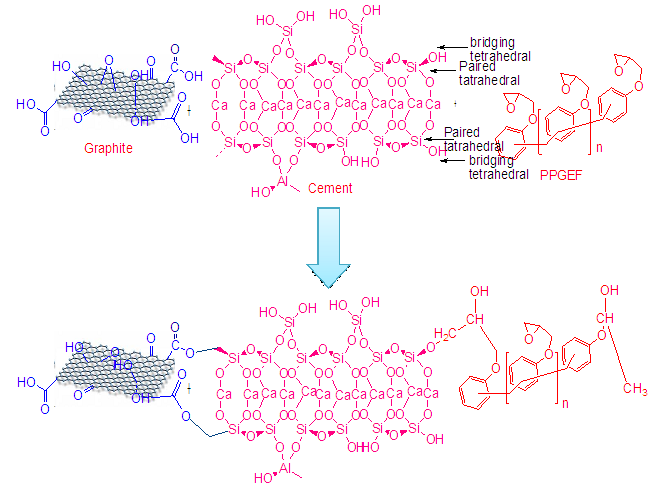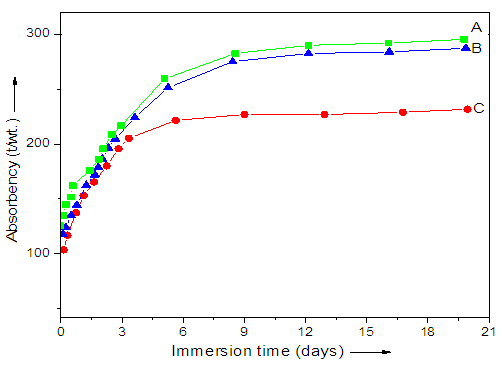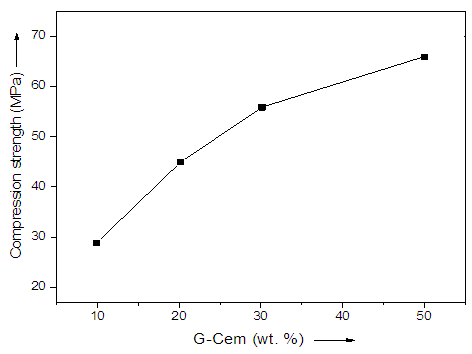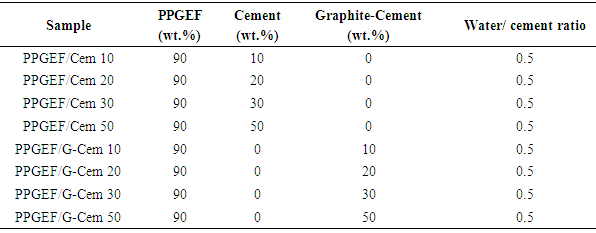-
Paper Information
- Paper Submission
-
Journal Information
- About This Journal
- Editorial Board
- Current Issue
- Archive
- Author Guidelines
- Contact Us
International Journal of Materials and Chemistry
p-ISSN: 2166-5346 e-ISSN: 2166-5354
2016; 6(1): 1-5
doi:10.5923/j.ijmc.20160601.01

Composite of Poly[(phenyl glycidyl ether)-co-formaldehyde] with Cement and Graphite-Cement
Ayesha Kausar
Nanosciences and Catalysis Division, National Centre For Physics, Quaid-i-Azam University Campus, Islamabad, Pakistan
Correspondence to: Ayesha Kausar , Nanosciences and Catalysis Division, National Centre For Physics, Quaid-i-Azam University Campus, Islamabad, Pakistan.
| Email: |  |
Copyright © 2016 Scientific & Academic Publishing. All Rights Reserved.
This work is licensed under the Creative Commons Attribution International License (CC BY).
http://creativecommons.org/licenses/by/4.0/

This paper describes the results related to the poly[(phenyl glycidyl ether)-co-formaldehyde] (PPGEF) and white Portland cement (Cem) composite. The effect of adding cement (Cem), and graphite-cement nanobifiller (Cem) on the properties of polymer/cement composites was considered. The physical parameters such as morphology, absorptivity, compressive strength, and compressive modulus of PPGEF/Cem and PPGEF/G-Cem composite were studied. There existed ester and ether bonding in PPGEF/G-Cem composite. The graphite-cement dispersed morphology was studied by scanning electron microscopic analysis. The nanobifiller was evenly distributed in the epoxy/cement matrix. The compressive strength and modulus were affected by the nanobifiller loading and interaction between PPGEF, graphite and cement. Moreover, the graphite-cement addition in polymer phase was significant to augment the mechanical properties of the materials.
Keywords: Poly[(phenyl glycidyl ether)-co-formaldehyde], Graphite, Cement, Composite, Compressive strength, Absorptivity
Cite this paper: Ayesha Kausar , Composite of Poly[(phenyl glycidyl ether)-co-formaldehyde] with Cement and Graphite-Cement, International Journal of Materials and Chemistry, Vol. 6 No. 1, 2016, pp. 1-5. doi: 10.5923/j.ijmc.20160601.01.
Article Outline
1. Introduction
- Preparation and properties of polymer/graphite composites has been paying attention by the researchers in current decades [1-3]. Graphite is naturally abundant allotrope of carbon which is made of entire carbon layers. In between the layers, carbon atoms are surrounded by van der Waals forces and the complete separation of graphite layers is hard because of higher crystal lattice energy [4, 5]. Numerous methods have been discussed for the synthesis of hybrids with advantageous physical properties and uniform integration of graphite particles in polymer matrix. Consequently the approaches for manufacture of polymer/graphite composites have been modified and improved. The frequent methods comprise polymer blending with graphite or polymer intercalation into interlayer spacing of graphite [6-9]. Nano-integration of extended graphite in several polymeric matrices such as polystyrene, poly(methyl methacrylate), and poly(vinyl chloride) by employing in-situ polymerization has been reported [10, 11]. The major aim of these techniques is to achieve homogeneous distribution of graphite in continuous polymer matrix. Principally, it is hard to obtain fine scattering because of inappropriateness of polymer and graphite. Therefore, it is essential to improve the complexity between the nano-filler and polymer. Usual polymer/graphite composites have been known to demonstrate decrease in physical properties (especially mechanical properties) because of deprived dispersion. Poor dispersion of filler may result in the bulk formation displaying to insufficient intercalation of macromolecules. The bulks may not be able to achieve closed cavities inside the extended graphite. During processing, the graphite sheets around cavities have the ability to overlap each other and form accumulated mass. The graphite addition into composite matrix may lead to significant changes of some aspects of the material properties. In addition to utilizing graphite, addition of polymeric phase cement-based composites has been frequently synthesized. The employment of polymeric matrices in cement has been used for the development of mechanical and physical properties of cement matrix [12]. In terms of microstructure, the polymeric phase is accomplished for coating of unhydrated cement grains which inhibits the hydration process partially, or completely. In some cases, existence of polymers in cement gives some internal products which inhibit crystals structure during the initial hydration [13]. However, polymer matrices in cement escort to considerable decline in porosity with consequent loss of free paths for crack propagation and improvement of mechanical strength [14]. Traditionally, cement-based materials have been formed by casting. Thus the porosity of the toughened materials is determined by amount of water employed. The excess of water is required for progress of workability of cement paste and efficiency for cement grains to agglomerate. This results in high porosity of toughened cement paste and a wide range of pore sizes [15]. Consequently, these are not very strong materials, and they hold severe faults and an open microstructure. Due to most permeability of polymers they have a general absorption mechanism examined by ion concentration gradient; therefore they demonstrate water absorbency under physical conditions (i.e. temperature and applied load). Although under chemical conditions such as high-valence metal ions and pH of the solvent, several porosity and porous forms have been determined [16]. The influence of epoxy resin on the mechanical performance of white Portland cement has been investigated [17]. The polymer/cement composites were mixed with altering weight percentages of resin in absence of water. The results exposed that the presence of the polymeric phase led to improvement in strength and decrease in the bulk density relative to that of pure cement. There was the creation of hydrated cement grains because of the presence of epoxy resin [18]. The influence of adding thermoset and water content into cementitious composites was also explored [19]. The polymer matrix addition provided not only reduction in apparent density and porosity, but also an increase in compressive strength of the composites. It was also established that the presence of water contributed to diminish in mechanical strength of cement-based composites. Graphite not only presents an increase of strength and toughness of nanocomposite, but can also be employed as piezoresistive sensors in smart materials. According to the research reports, by applying a stress field the electrical resistance of cementitious composites with carbon filler was altered. Thus the composites represented substantial potential as stress/strain sensors for civil engineering structures [20]. The employment of chemical additives provided a consistent scattering of filler in cement paste which may affect the final properties of composite [21, 22]. By the addition of epoxy resin in cement paste, one can principally obtain a material with exceptional mechanical features from a structural engineering perception (low density, high toughness and strength). Moreover, for complex heterogeneous materials such as cement-based composites with polymer matrices, the influence of nanophase addition to constituents may be difficult to establish with other environmental factors (water fraction, polymer/cement ratio, manufacturing process). This work describes poly[(phenyl glycidyl ether)-co-formaldehyde] (PPGEF) and cement-based composites. Some novel composites of PPGEF and graphite-cement bifiller were also prepared. The effect of doping polymer/cement composite materials with graphite has been studied. Prior to reinforcement, graphite was acid functionalized to develop interaction with cement and polymer. The morphology, absorptivity, compressive strength and modulus were investigated. The interaction effects between the graphite and polymer/cement composite and influence on physical properties of the nanocomposites have been evaluated.
2. Experimental
2.1. Materials
- Poly[(phenyl glycidyl ether)-co-formaldehyde] (average Mn ~345), graphite (powder, 99%) and nitric acid were purchased from Aldrich. White Portland cement was obtained from local supplier.
2.2. Characterization Techniques
- IR spectra were taken at room temperature with a resolution of 4 cm-1 using Excalibur Series FTIR Spectrometer, Model No. FTSW 300 MX manufactured by BIO-RAD. The compression strength and modulus were measured with a universal electronic tensile machine (Shimadzu, Japan) at a compressive rate of 2 mm/min according to ASTM D 1621-94. The scanning electron microscopic (SEM) images were obtained by Scanning Electron Microscope S-4700 (Japan Hitachi Co. Ltd.).
2.3. Graphite Treatment
- The graphite powder was refluxed in concentrated nitric acid at 70°C. Then mixture was added to 500 mL of deionized water. The mixture was filtered and washed several times with deionized water to obtain pH ~ 6 [23, 24].
2.4. Formation of Graphite-cement (G-Cem)
- Graphite-cement hybrid filler was formed by ball milling of equal wt. % of graphite and cement. The mixture was milled for 24 h before use as filler.
2.5. Poly[(phenyl glycidyl ether)-co-formaldehyde] /graphite-cement (PPGEF/G-Cem)
- Hobart mixer was used to mix the desired amount of raw materials (PPGEF, G-Cem, and water). The mixture was processed for 0.5 h. Plastic moulds were used to produce cylindrical samples with diameter of 30 mm. The setting time for the air sealed samples was 9 days at room temperature [25]. Sample code and composition of PPGEF/G-Cem composite are given in Table 1.
|
2.6. PPGEF/Cem Composite Preparation
- PPGEF/Cem composite was also prepared using the analogous procedure mentioned in Section 2.5. The ratio of the PPGEF and cement was kept same as the other samples prepared. The difference was that the composite was reinforced with cement alone and not the graphite-cement hybrid.
3. Results and Discussion
3.1. Microscopic Studies of PPGEF/Cem and PPGEF/G-Cem Composite
- Fig. 1 shows the images of PPGEF/Cem 10 (Fig. 1A), PPGEF/Cem 30 (Fig. 1B), and PPGEF/Cem 50 (Fig. 1C) composites. In Fig. 1A & B, it is possible to examine the gathering of cement particles spread and embedded in the polymer samples. The cement tends to cluster due to physical interaction between the cement particles leading to agglomeration in the matrix. However, at all the cement concentrations loaded the particles were merged in the matrix and not visible at the fractured surface. Fig. 1D and Fig. 1E show the morphology of PPGEF/G-Cem 10 and PPGEF/G-Cem 50 composite. There was development of chemical bonding i.e. ester linkage in the nanofiller structure and formation of ether and alcoholic linkages between the nanobifiller structure and the polymer matrix (Fig. 2).
 | Figure 1. FESEM images of (A) PPGEF/Cem 10; (B) PPGEF/Cem 30; (C) PPGEF/Cem 50; (D) PPGEF/G-Cem 10 ; and (E) PPGEF/G-Cem 50 |
 | Figure 2. Formation of PPGEF/G-Cem composite |
3.2. Absorptivity of PPGEF/G-Cem Composite
- The absorption power of PPGEF/G-Cem 10-50 composite series was also measured using 1% NaCl solution with time. Fig. 3 shows the absorbency of graphite-cement-based absorbent materials. The absorbency of PPGEF/G-Cem 50 composite was highest in NaCl solution. PPGEF/G-Cem 30 material showed a reduction of absorbency relative to PPGEF/G-Cem 50. The lower absorbency was observed for PPGEF/G-Cem 10. The results imply that the increasing the bifiller content up to 50% in PPGEF/G-Cem showed a large increase of absorbency. In 10 wt. % composite, the filler content was not sufficient to incorporate ionic electrolyte between the polymer main chains. Whereas, in PPGEF/G-Cem 50 NaCl solution incorporated well in the polymer/G-Cem network. Nevertheless, the absorptivity was found to continuously increase with time in all the composites [26].
 | Figure 3. Absorbency of composites (A) PPGEF/G-Cem 10; (B) PPGEF/G-Cem 30; and (C) PPGEF/G-Cem 50 with time |
3.3. Compressive Strength and Modulus
- Table 2 depicts the compressive strength and modulus of the composites increasing progressively with the increase in filler content from 10 to 50 wt. % [27]. Fig. 4 shows the compression strength of PPGEF/G-Cem composites, while compression modulus is given in Fig. 5. PPGEF/Cem 10 composite possess compression strength of 20.1 MPa and compression modulus of 5.5 GPa. The mechanical properties were progressively increased in this series and higher values were observed for 50 wt.% filler loading. PPGEF/Cem 50 composite had compression strength of 40.1 MPa and compression modulus of 11.2 GPa. Addition of G-Cem in the second series of the composite yielded more pronounced results.
|
 | Figure 4. Compression strength of PPGEF/G-Cem composite |
 | Figure 5. Compression modulus of PPGEF/G-Cem composite |
4. Conclusions
- This research deals with the influence of cement and graphite-cement inclusions on the mechanical and other physical properties of poly[(phenyl glycidyl ether)-co-formaldehyde]. In these composites, resin was the matrix phase while the cementious phase was filler/reinforcement. Both the cement and graphite-cement contents were varied to study the affect on final composite properties. The addition of G-Cem in polymeric phase also provided lower bulk density and higher absorptivity due to cementitious phase. The microstructural analysis revealed good interface interaction between the graphite-cement and thermoset phase. The addition of G-Cem contributed to increase in the compression strength and modulus. The composite manufactured with 50 wt. % of G-Cem phase exhibited superior compressive strength. The inclusion of cement and bifiller into cementitious materials is potentially important for civil structures monitoring.
 Abstract
Abstract Reference
Reference Full-Text PDF
Full-Text PDF Full-text HTML
Full-text HTML
